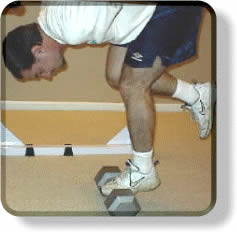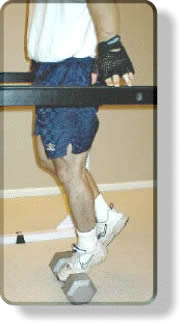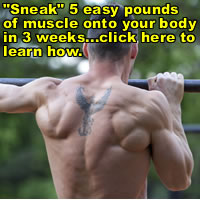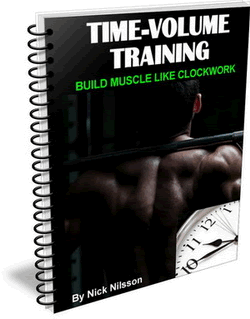The calves are one of the most challenging muscle groups in the body to build.
They are tough, resilient and painful to work. Those who genetically have them often take them for granted, but for the rest of us who have to fight for every inch of muscle in the lower legs, nothing is more rewarding than seeing the calves develop and grow.

When it comes to calf training, there is very little in terms of variety.. Your basic moves are standing calf raises, seated calf raises and donkey calf raises. Everything else is basically just a variation of one of the three.
Until now...
Full-Range Calf Raises, which you are about to learn, are actually a variation that combines TWO of the three basic movements for the calves! It's an exercise that doesn't require extra weight yet still allows for very powerful stimulation of the calves, even in advanced trainers.
Why Is This Exercise So Effective?
To answer that question, we need to examine the biomechanics of the two calf movements we'll be combining: the donkey calf raise and the standing calf raise. I will explain each exercise and which parts we are going to take to use for the Full-Range Calf Raise. The next section will explain how we'll be combining them.
Donkey Calf Raises are done by placing the feet on a raised block, bending over at the waist and resting your arms on a solid object in front of you. Weight can be added directly over the hips either by using machines, having a partner sit on your back, or adding a hip belt with weight.
The primary benefit of the donkey calf raise lies in the stretch position. At the bottom of a standing calf raise, your calves are only getting stretched at the ankle. Since the Gastrocnemius (one of the two major calf muscles) also crosses the knee joint and ties in with the hamstrings, this stretching at the ankle gives you only part of the stretch.
When you are bent over at the waist in the donkey calf raise position, the position of the hip stretches the hamstrings, which also increases the stretch on the calves.
For the Full-Range Calf Raise, we're going to MAXIMIZE the combined stretch on the calves by starting from a completely bent-over position, like you are touching your toes while at the bottom of a calf raise. At this point, you are getting the MOST stretch on your calves that is anatomically possible.
Now we move to the Standing Calf Raise. This exercise is done in a standing position on a raised surface like a block or stair edge, lowering your heels then raising your heels using the calves.
The primary benefit of the Standing Calf Raise that we're going to exploit is the top, contracted position.
When the body is upright and vertical and the legs are straight, your calves are able to achieve their peak contracted position.
Here's the hitch...your body needs help to achieve the ABSOLUTE peak contracted position. When you get to the very top of the exercise and achieve a strong contraction (especially when using extra weight or working on one leg at a time), the calves aren't quite strong enough to get to the VERY top position all on their own. They can get very close (and it sure feels like the top) but a little assistance at this point, rather than decreasing tension on the calves, will actually INCREASE the tension even further.
Now we're going to take the best parts of each of the two movements, maximum anatomical stretch and maximum anatomical contraction, and mesh them into one power-packed movement. You won't believe how this will exercise will pump up even the most "hard-to-build" calf muscles.
How To Do Full-Range Calf Raises:
The first thing to note here is that this an exercise that you need to FEEL working and concentrate on feeling working to get the best results. It is done slowly and deliberately, with pauses at the stretch and contracted positions. Simply going through the motions will get you nothing.
This exercise is done one leg at a time. Set up with the balls of your foot on a raised block (any raised surface such as a step or even a dumbbell handle will work). Be sure you have something solid in front of you that you grab for balance and to adjust your body position (more on that below).
|
Now, keeping your leg as straight as you can, bend over as though touching your toes. Hold onto something solid for balance here.
Stretch your heel down as far as possible and stretch your upper body down as far as possible without bending your leg. This is the maximal stretch position for the calves (like I explained with the Donkey Calf Raise) and you should feel a very intense stretch. Hold this position for 5 seconds, sinking into the stretch.

Now, while staying in that completely bent-over position, very deliberately rise up as far as you can as though doing a bent-over standing calf raise, feeling the calves working hard from that maximum-stretch position.
At full extension of the ankle from the bent-over movement (the top of the bent-over calf raise) and WITHOUT releasing the tension in the calves, use your hands to "climb" the object you are using for balance and straighten up at the waist so you are now in a one-legged calf raise position. At this point, your foot position will look as though you are part-way through the standing calf-raise movement already. The key is to keep the tension on the calf as you straighten your body position.
From there, continue up to the full contraction of the calf by finishing the calf raise movement. Squeeze your calf as hard as you can. Feel the contraction?
You're not done. At the very top, use the same object you're holding for balance to PUSH yourself up a little higher.

Using this push takes up some of your bodyweight, allowing the calf to achieve the VERY maximum anatomically-possible peak contraction that I mentioned above.
Hold this position for at least 5 seconds, squeezing your calf as hard as you can. Lower yourself to the bottom position of the standing calf raise then bend over at the waist, using your hands to walk yourself back down. Get back into the maximum stretch position then repeat.
Do all of your reps on one leg then switch to the other leg. This allows you to keep full tension on the calf for the entire set.
This is a VERY intense exercise and doesn't require many reps to really get the calves pumped up.
Common Errors:
1. Moving too fast
Take your time as you do the movement to ensure your calves are getting maximum tension throughout the entire range of motion. This exercise is all about tension, not how many reps you can do or how much weight you can use.
2. Releasing the tension
This can happen when you are straightening up after finishing the bent-over phase. Be sure to keep the tension on the calf muscle as you straighten up. What makes the exercise so effective is that you are taking the muscle through its entire anatomical range of motion under tension the whole way.
3. Not emphasizing the stretch or contraction
Make a concentrated effort to get the maximum stretch at the bottom and the maximum contraction at the top.
Conclusion:
If you're looking for a great bodyweight exercise to take on the road or something to really shock your calves, give the Full-Range Calf Raise a try. The look on your face as you do it will tell you all you need to know about its effectiveness.
Learn 5 tips for better calf development here.
![]()
More From Fitstep.com
| Exponential Drop Sets...Murderous Training for Massive Growth | |
| Why I Hate Supplements | |
| Where Do I Start With Fitness? Start Here. | |
| 16 Tips and Tricks For a Bigger, Better Squat |
Share This Page...
---
Home -> Exercise Library -> Calf Exercises -> Full-Range Calf Raises



